Pricing Models: Evaluation for SMEs & Product Life Cycle - 244
VerifiedAdded on 2023/06/12
|8
|2282
|95
Report
AI Summary
This report provides an in-depth analysis of pricing models relevant to Small and Medium Enterprises (SMEs). It begins by introducing the significance of pricing within the marketing mix, highlighting cost-based, value-based, and competition-based pricing strategies. The report explores various pricing models such as cost-based, demand-based, competition-based, and value pricing, discussing their respective advantages and disadvantages. It also examines the influence of the product life cycle on pricing decisions, including strategies for the introduction, maturity, and decline stages. Numerical examples are provided to illustrate the application of these models in real-world scenarios. The report concludes that pricing models are crucial for effective price setting, with different industries adopting varied strategies based on market dynamics, emphasizing the importance of understanding the advantages and disadvantages of each model for successful implementation.

PRICING MODELS
Paraphrase This Document
Need a fresh take? Get an instant paraphrase of this document with our AI Paraphraser

Table of Contents
INTRODUCTION...........................................................................................................................1
MAIN BODY...................................................................................................................................1
CONCLUSION................................................................................................................................5
REFERENCES................................................................................................................................6
INTRODUCTION...........................................................................................................................1
MAIN BODY...................................................................................................................................1
CONCLUSION................................................................................................................................5
REFERENCES................................................................................................................................6
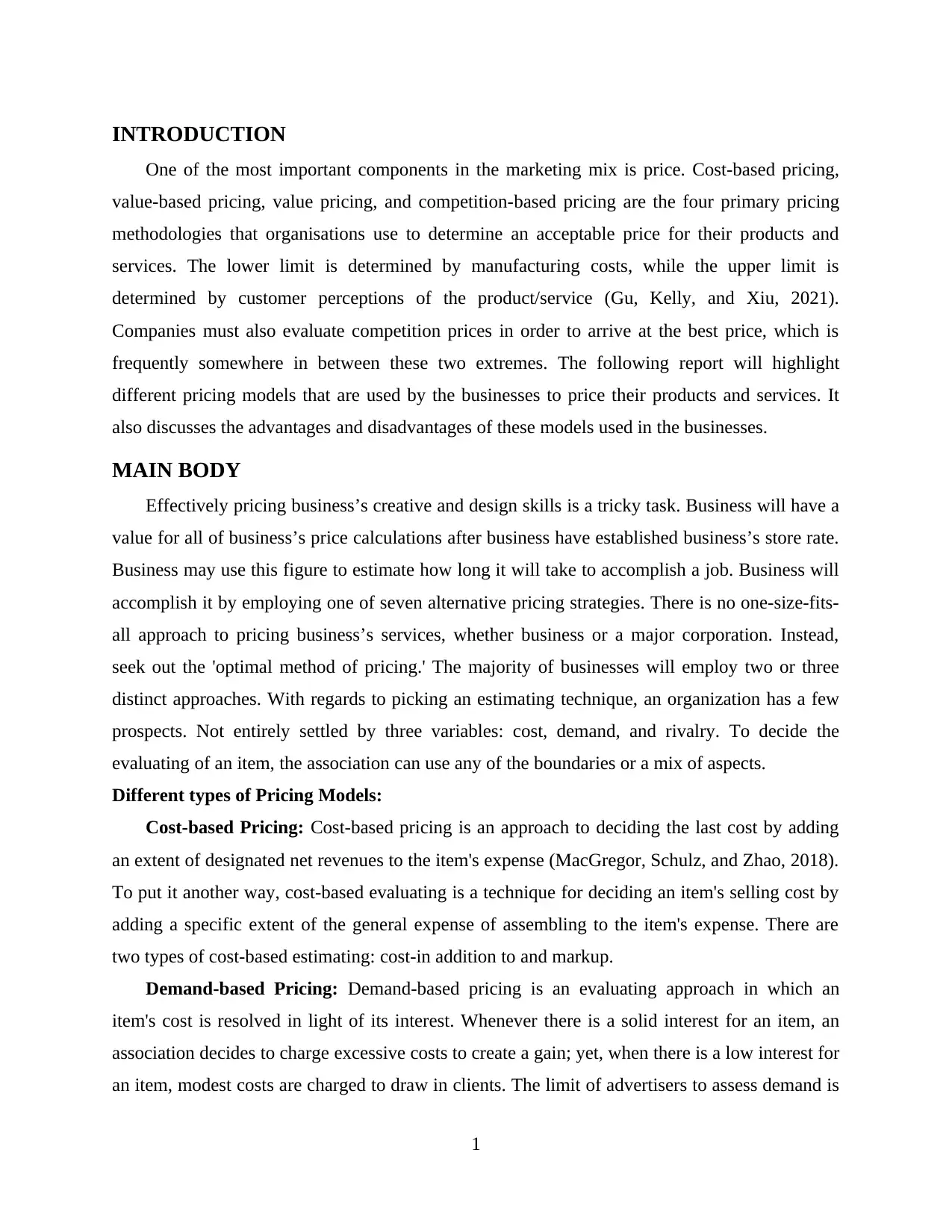
INTRODUCTION
One of the most important components in the marketing mix is price. Cost-based pricing,
value-based pricing, value pricing, and competition-based pricing are the four primary pricing
methodologies that organisations use to determine an acceptable price for their products and
services. The lower limit is determined by manufacturing costs, while the upper limit is
determined by customer perceptions of the product/service (Gu, Kelly, and Xiu, 2021).
Companies must also evaluate competition prices in order to arrive at the best price, which is
frequently somewhere in between these two extremes. The following report will highlight
different pricing models that are used by the businesses to price their products and services. It
also discusses the advantages and disadvantages of these models used in the businesses.
MAIN BODY
Effectively pricing business’s creative and design skills is a tricky task. Business will have a
value for all of business’s price calculations after business have established business’s store rate.
Business may use this figure to estimate how long it will take to accomplish a job. Business will
accomplish it by employing one of seven alternative pricing strategies. There is no one-size-fits-
all approach to pricing business’s services, whether business or a major corporation. Instead,
seek out the 'optimal method of pricing.' The majority of businesses will employ two or three
distinct approaches. With regards to picking an estimating technique, an organization has a few
prospects. Not entirely settled by three variables: cost, demand, and rivalry. To decide the
evaluating of an item, the association can use any of the boundaries or a mix of aspects.
Different types of Pricing Models:
Cost-based Pricing: Cost-based pricing is an approach to deciding the last cost by adding
an extent of designated net revenues to the item's expense (MacGregor, Schulz, and Zhao, 2018).
To put it another way, cost-based evaluating is a technique for deciding an item's selling cost by
adding a specific extent of the general expense of assembling to the item's expense. There are
two types of cost-based estimating: cost-in addition to and markup.
Demand-based Pricing: Demand-based pricing is an evaluating approach in which an
item's cost is resolved in light of its interest. Whenever there is a solid interest for an item, an
association decides to charge excessive costs to create a gain; yet, when there is a low interest for
an item, modest costs are charged to draw in clients. The limit of advertisers to assess demand is
1
One of the most important components in the marketing mix is price. Cost-based pricing,
value-based pricing, value pricing, and competition-based pricing are the four primary pricing
methodologies that organisations use to determine an acceptable price for their products and
services. The lower limit is determined by manufacturing costs, while the upper limit is
determined by customer perceptions of the product/service (Gu, Kelly, and Xiu, 2021).
Companies must also evaluate competition prices in order to arrive at the best price, which is
frequently somewhere in between these two extremes. The following report will highlight
different pricing models that are used by the businesses to price their products and services. It
also discusses the advantages and disadvantages of these models used in the businesses.
MAIN BODY
Effectively pricing business’s creative and design skills is a tricky task. Business will have a
value for all of business’s price calculations after business have established business’s store rate.
Business may use this figure to estimate how long it will take to accomplish a job. Business will
accomplish it by employing one of seven alternative pricing strategies. There is no one-size-fits-
all approach to pricing business’s services, whether business or a major corporation. Instead,
seek out the 'optimal method of pricing.' The majority of businesses will employ two or three
distinct approaches. With regards to picking an estimating technique, an organization has a few
prospects. Not entirely settled by three variables: cost, demand, and rivalry. To decide the
evaluating of an item, the association can use any of the boundaries or a mix of aspects.
Different types of Pricing Models:
Cost-based Pricing: Cost-based pricing is an approach to deciding the last cost by adding
an extent of designated net revenues to the item's expense (MacGregor, Schulz, and Zhao, 2018).
To put it another way, cost-based evaluating is a technique for deciding an item's selling cost by
adding a specific extent of the general expense of assembling to the item's expense. There are
two types of cost-based estimating: cost-in addition to and markup.
Demand-based Pricing: Demand-based pricing is an evaluating approach in which an
item's cost is resolved in light of its interest. Whenever there is a solid interest for an item, an
association decides to charge excessive costs to create a gain; yet, when there is a low interest for
an item, modest costs are charged to draw in clients. The limit of advertisers to assess demand is
1
You're viewing a preview
Unlock full access by subscribing today!
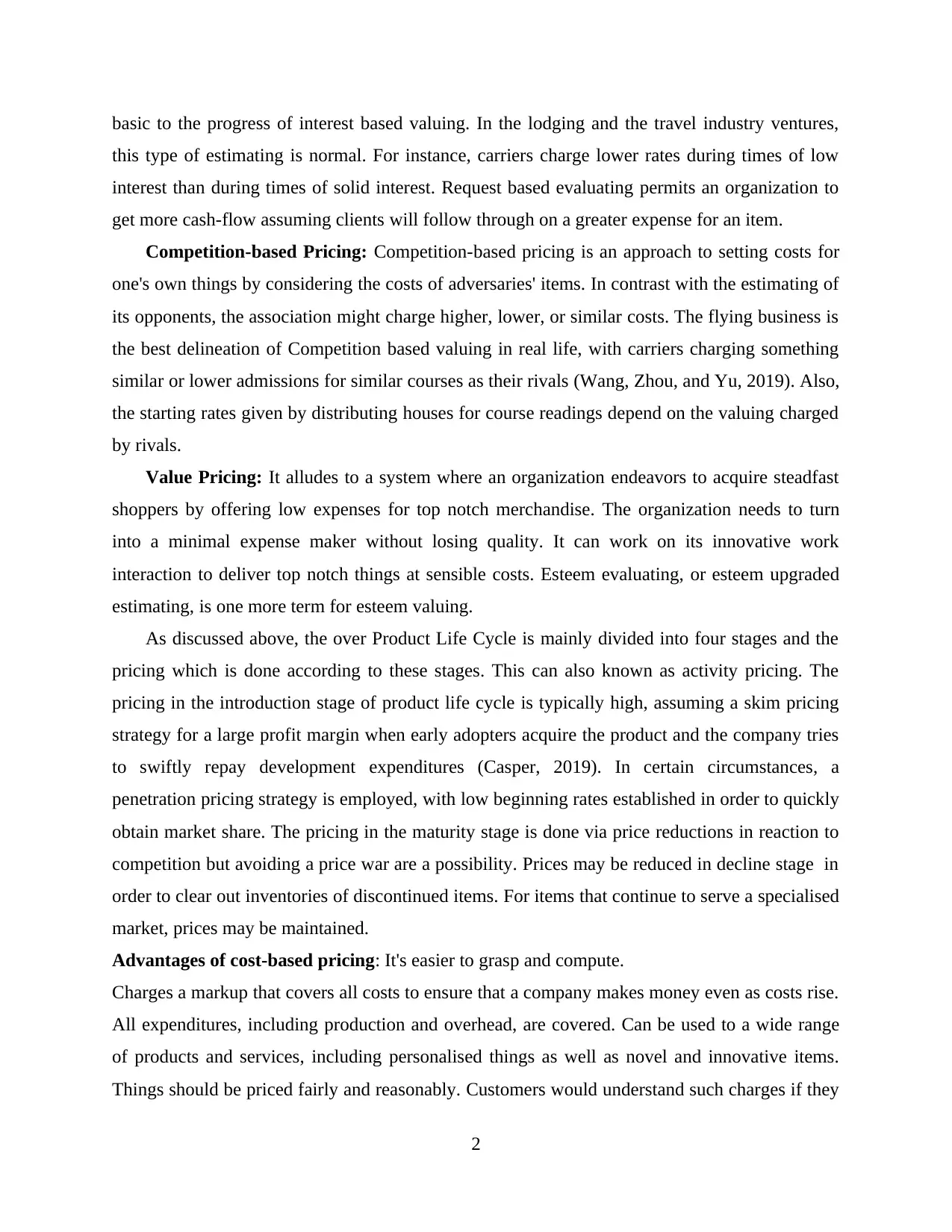
basic to the progress of interest based valuing. In the lodging and the travel industry ventures,
this type of estimating is normal. For instance, carriers charge lower rates during times of low
interest than during times of solid interest. Request based evaluating permits an organization to
get more cash-flow assuming clients will follow through on a greater expense for an item.
Competition-based Pricing: Competition-based pricing is an approach to setting costs for
one's own things by considering the costs of adversaries' items. In contrast with the estimating of
its opponents, the association might charge higher, lower, or similar costs. The flying business is
the best delineation of Competition based valuing in real life, with carriers charging something
similar or lower admissions for similar courses as their rivals (Wang, Zhou, and Yu, 2019). Also,
the starting rates given by distributing houses for course readings depend on the valuing charged
by rivals.
Value Pricing: It alludes to a system where an organization endeavors to acquire steadfast
shoppers by offering low expenses for top notch merchandise. The organization needs to turn
into a minimal expense maker without losing quality. It can work on its innovative work
interaction to deliver top notch things at sensible costs. Esteem evaluating, or esteem upgraded
estimating, is one more term for esteem valuing.
As discussed above, the over Product Life Cycle is mainly divided into four stages and the
pricing which is done according to these stages. This can also known as activity pricing. The
pricing in the introduction stage of product life cycle is typically high, assuming a skim pricing
strategy for a large profit margin when early adopters acquire the product and the company tries
to swiftly repay development expenditures (Casper, 2019). In certain circumstances, a
penetration pricing strategy is employed, with low beginning rates established in order to quickly
obtain market share. The pricing in the maturity stage is done via price reductions in reaction to
competition but avoiding a price war are a possibility. Prices may be reduced in decline stage in
order to clear out inventories of discontinued items. For items that continue to serve a specialised
market, prices may be maintained.
Advantages of cost-based pricing: It's easier to grasp and compute.
Charges a markup that covers all costs to ensure that a company makes money even as costs rise.
All expenditures, including production and overhead, are covered. Can be used to a wide range
of products and services, including personalised things as well as novel and innovative items.
Things should be priced fairly and reasonably. Customers would understand such charges if they
2
this type of estimating is normal. For instance, carriers charge lower rates during times of low
interest than during times of solid interest. Request based evaluating permits an organization to
get more cash-flow assuming clients will follow through on a greater expense for an item.
Competition-based Pricing: Competition-based pricing is an approach to setting costs for
one's own things by considering the costs of adversaries' items. In contrast with the estimating of
its opponents, the association might charge higher, lower, or similar costs. The flying business is
the best delineation of Competition based valuing in real life, with carriers charging something
similar or lower admissions for similar courses as their rivals (Wang, Zhou, and Yu, 2019). Also,
the starting rates given by distributing houses for course readings depend on the valuing charged
by rivals.
Value Pricing: It alludes to a system where an organization endeavors to acquire steadfast
shoppers by offering low expenses for top notch merchandise. The organization needs to turn
into a minimal expense maker without losing quality. It can work on its innovative work
interaction to deliver top notch things at sensible costs. Esteem evaluating, or esteem upgraded
estimating, is one more term for esteem valuing.
As discussed above, the over Product Life Cycle is mainly divided into four stages and the
pricing which is done according to these stages. This can also known as activity pricing. The
pricing in the introduction stage of product life cycle is typically high, assuming a skim pricing
strategy for a large profit margin when early adopters acquire the product and the company tries
to swiftly repay development expenditures (Casper, 2019). In certain circumstances, a
penetration pricing strategy is employed, with low beginning rates established in order to quickly
obtain market share. The pricing in the maturity stage is done via price reductions in reaction to
competition but avoiding a price war are a possibility. Prices may be reduced in decline stage in
order to clear out inventories of discontinued items. For items that continue to serve a specialised
market, prices may be maintained.
Advantages of cost-based pricing: It's easier to grasp and compute.
Charges a markup that covers all costs to ensure that a company makes money even as costs rise.
All expenditures, including production and overhead, are covered. Can be used to a wide range
of products and services, including personalised things as well as novel and innovative items.
Things should be priced fairly and reasonably. Customers would understand such charges if they
2
Paraphrase This Document
Need a fresh take? Get an instant paraphrase of this document with our AI Paraphraser
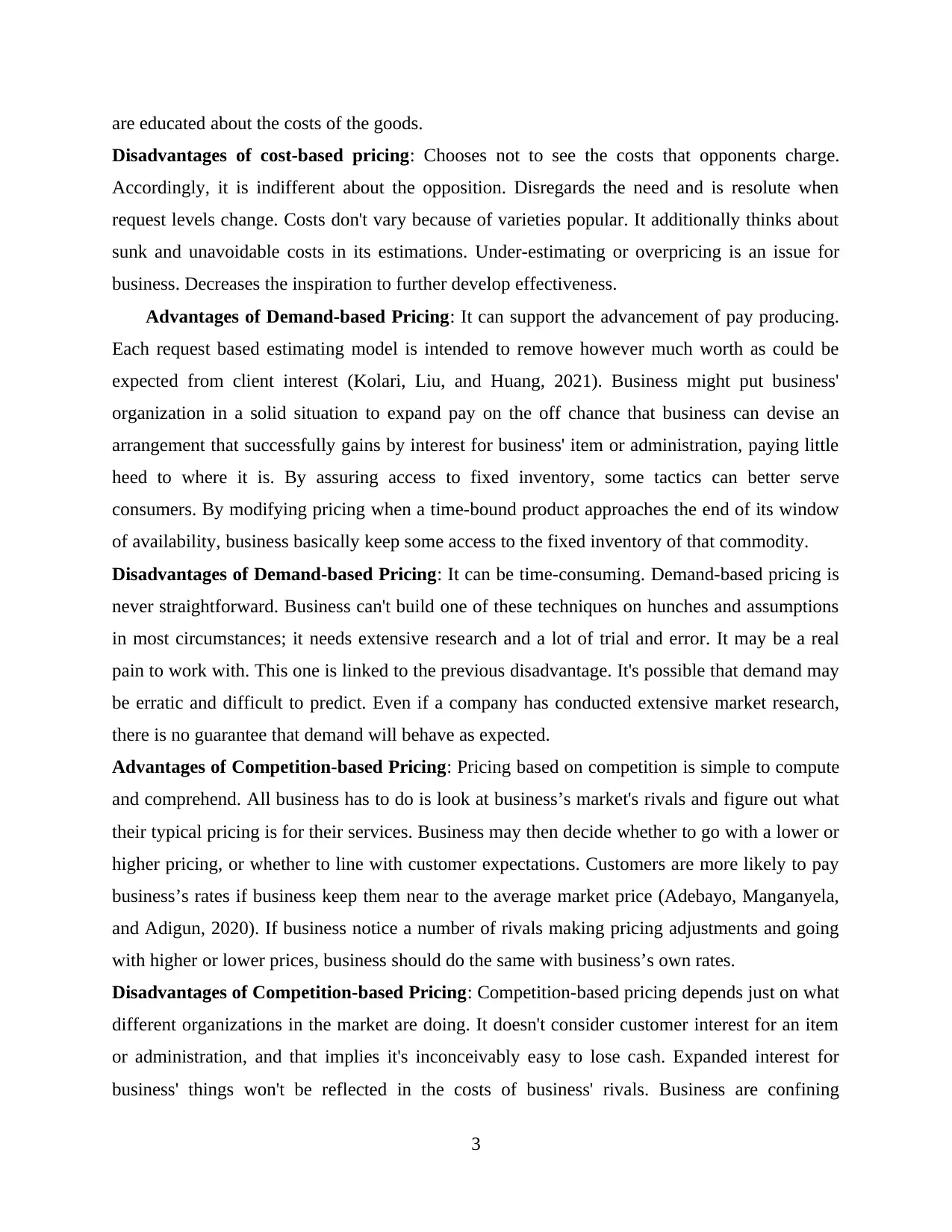
are educated about the costs of the goods.
Disadvantages of cost-based pricing: Chooses not to see the costs that opponents charge.
Accordingly, it is indifferent about the opposition. Disregards the need and is resolute when
request levels change. Costs don't vary because of varieties popular. It additionally thinks about
sunk and unavoidable costs in its estimations. Under-estimating or overpricing is an issue for
business. Decreases the inspiration to further develop effectiveness.
Advantages of Demand-based Pricing: It can support the advancement of pay producing.
Each request based estimating model is intended to remove however much worth as could be
expected from client interest (Kolari, Liu, and Huang, 2021). Business might put business'
organization in a solid situation to expand pay on the off chance that business can devise an
arrangement that successfully gains by interest for business' item or administration, paying little
heed to where it is. By assuring access to fixed inventory, some tactics can better serve
consumers. By modifying pricing when a time-bound product approaches the end of its window
of availability, business basically keep some access to the fixed inventory of that commodity.
Disadvantages of Demand-based Pricing: It can be time-consuming. Demand-based pricing is
never straightforward. Business can't build one of these techniques on hunches and assumptions
in most circumstances; it needs extensive research and a lot of trial and error. It may be a real
pain to work with. This one is linked to the previous disadvantage. It's possible that demand may
be erratic and difficult to predict. Even if a company has conducted extensive market research,
there is no guarantee that demand will behave as expected.
Advantages of Competition-based Pricing: Pricing based on competition is simple to compute
and comprehend. All business has to do is look at business’s market's rivals and figure out what
their typical pricing is for their services. Business may then decide whether to go with a lower or
higher pricing, or whether to line with customer expectations. Customers are more likely to pay
business’s rates if business keep them near to the average market price (Adebayo, Manganyela,
and Adigun, 2020). If business notice a number of rivals making pricing adjustments and going
with higher or lower prices, business should do the same with business’s own rates.
Disadvantages of Competition-based Pricing: Competition-based pricing depends just on what
different organizations in the market are doing. It doesn't consider customer interest for an item
or administration, and that implies it's inconceivably easy to lose cash. Expanded interest for
business' things won't be reflected in the costs of business' rivals. Business are confining
3
Disadvantages of cost-based pricing: Chooses not to see the costs that opponents charge.
Accordingly, it is indifferent about the opposition. Disregards the need and is resolute when
request levels change. Costs don't vary because of varieties popular. It additionally thinks about
sunk and unavoidable costs in its estimations. Under-estimating or overpricing is an issue for
business. Decreases the inspiration to further develop effectiveness.
Advantages of Demand-based Pricing: It can support the advancement of pay producing.
Each request based estimating model is intended to remove however much worth as could be
expected from client interest (Kolari, Liu, and Huang, 2021). Business might put business'
organization in a solid situation to expand pay on the off chance that business can devise an
arrangement that successfully gains by interest for business' item or administration, paying little
heed to where it is. By assuring access to fixed inventory, some tactics can better serve
consumers. By modifying pricing when a time-bound product approaches the end of its window
of availability, business basically keep some access to the fixed inventory of that commodity.
Disadvantages of Demand-based Pricing: It can be time-consuming. Demand-based pricing is
never straightforward. Business can't build one of these techniques on hunches and assumptions
in most circumstances; it needs extensive research and a lot of trial and error. It may be a real
pain to work with. This one is linked to the previous disadvantage. It's possible that demand may
be erratic and difficult to predict. Even if a company has conducted extensive market research,
there is no guarantee that demand will behave as expected.
Advantages of Competition-based Pricing: Pricing based on competition is simple to compute
and comprehend. All business has to do is look at business’s market's rivals and figure out what
their typical pricing is for their services. Business may then decide whether to go with a lower or
higher pricing, or whether to line with customer expectations. Customers are more likely to pay
business’s rates if business keep them near to the average market price (Adebayo, Manganyela,
and Adigun, 2020). If business notice a number of rivals making pricing adjustments and going
with higher or lower prices, business should do the same with business’s own rates.
Disadvantages of Competition-based Pricing: Competition-based pricing depends just on what
different organizations in the market are doing. It doesn't consider customer interest for an item
or administration, and that implies it's inconceivably easy to lose cash. Expanded interest for
business' things won't be reflected in the costs of business' rivals. Business are confining
3
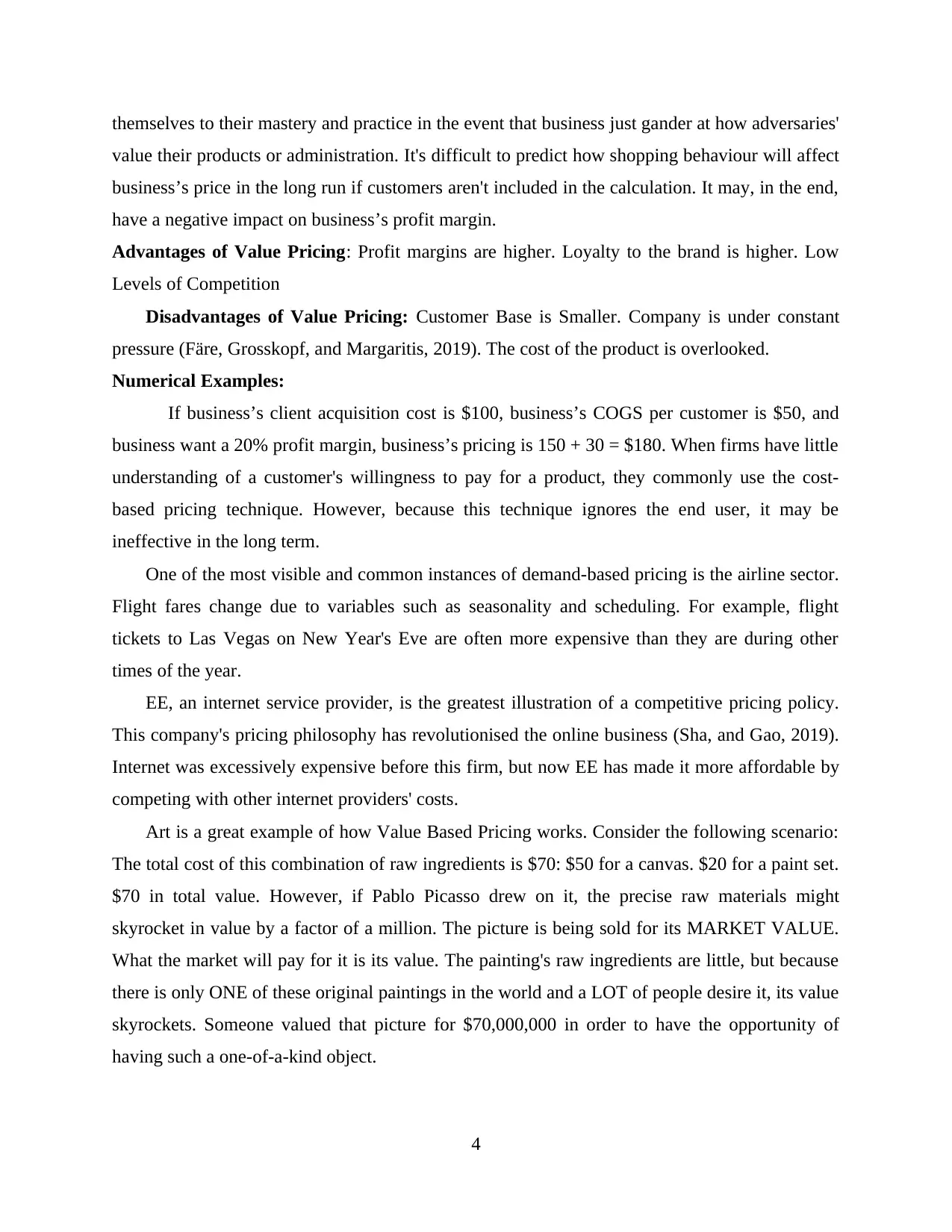
themselves to their mastery and practice in the event that business just gander at how adversaries'
value their products or administration. It's difficult to predict how shopping behaviour will affect
business’s price in the long run if customers aren't included in the calculation. It may, in the end,
have a negative impact on business’s profit margin.
Advantages of Value Pricing: Profit margins are higher. Loyalty to the brand is higher. Low
Levels of Competition
Disadvantages of Value Pricing: Customer Base is Smaller. Company is under constant
pressure (Färe, Grosskopf, and Margaritis, 2019). The cost of the product is overlooked.
Numerical Examples:
If business’s client acquisition cost is $100, business’s COGS per customer is $50, and
business want a 20% profit margin, business’s pricing is 150 + 30 = $180. When firms have little
understanding of a customer's willingness to pay for a product, they commonly use the cost-
based pricing technique. However, because this technique ignores the end user, it may be
ineffective in the long term.
One of the most visible and common instances of demand-based pricing is the airline sector.
Flight fares change due to variables such as seasonality and scheduling. For example, flight
tickets to Las Vegas on New Year's Eve are often more expensive than they are during other
times of the year.
EE, an internet service provider, is the greatest illustration of a competitive pricing policy.
This company's pricing philosophy has revolutionised the online business (Sha, and Gao, 2019).
Internet was excessively expensive before this firm, but now EE has made it more affordable by
competing with other internet providers' costs.
Art is a great example of how Value Based Pricing works. Consider the following scenario:
The total cost of this combination of raw ingredients is $70: $50 for a canvas. $20 for a paint set.
$70 in total value. However, if Pablo Picasso drew on it, the precise raw materials might
skyrocket in value by a factor of a million. The picture is being sold for its MARKET VALUE.
What the market will pay for it is its value. The painting's raw ingredients are little, but because
there is only ONE of these original paintings in the world and a LOT of people desire it, its value
skyrockets. Someone valued that picture for $70,000,000 in order to have the opportunity of
having such a one-of-a-kind object.
4
value their products or administration. It's difficult to predict how shopping behaviour will affect
business’s price in the long run if customers aren't included in the calculation. It may, in the end,
have a negative impact on business’s profit margin.
Advantages of Value Pricing: Profit margins are higher. Loyalty to the brand is higher. Low
Levels of Competition
Disadvantages of Value Pricing: Customer Base is Smaller. Company is under constant
pressure (Färe, Grosskopf, and Margaritis, 2019). The cost of the product is overlooked.
Numerical Examples:
If business’s client acquisition cost is $100, business’s COGS per customer is $50, and
business want a 20% profit margin, business’s pricing is 150 + 30 = $180. When firms have little
understanding of a customer's willingness to pay for a product, they commonly use the cost-
based pricing technique. However, because this technique ignores the end user, it may be
ineffective in the long term.
One of the most visible and common instances of demand-based pricing is the airline sector.
Flight fares change due to variables such as seasonality and scheduling. For example, flight
tickets to Las Vegas on New Year's Eve are often more expensive than they are during other
times of the year.
EE, an internet service provider, is the greatest illustration of a competitive pricing policy.
This company's pricing philosophy has revolutionised the online business (Sha, and Gao, 2019).
Internet was excessively expensive before this firm, but now EE has made it more affordable by
competing with other internet providers' costs.
Art is a great example of how Value Based Pricing works. Consider the following scenario:
The total cost of this combination of raw ingredients is $70: $50 for a canvas. $20 for a paint set.
$70 in total value. However, if Pablo Picasso drew on it, the precise raw materials might
skyrocket in value by a factor of a million. The picture is being sold for its MARKET VALUE.
What the market will pay for it is its value. The painting's raw ingredients are little, but because
there is only ONE of these original paintings in the world and a LOT of people desire it, its value
skyrockets. Someone valued that picture for $70,000,000 in order to have the opportunity of
having such a one-of-a-kind object.
4
You're viewing a preview
Unlock full access by subscribing today!
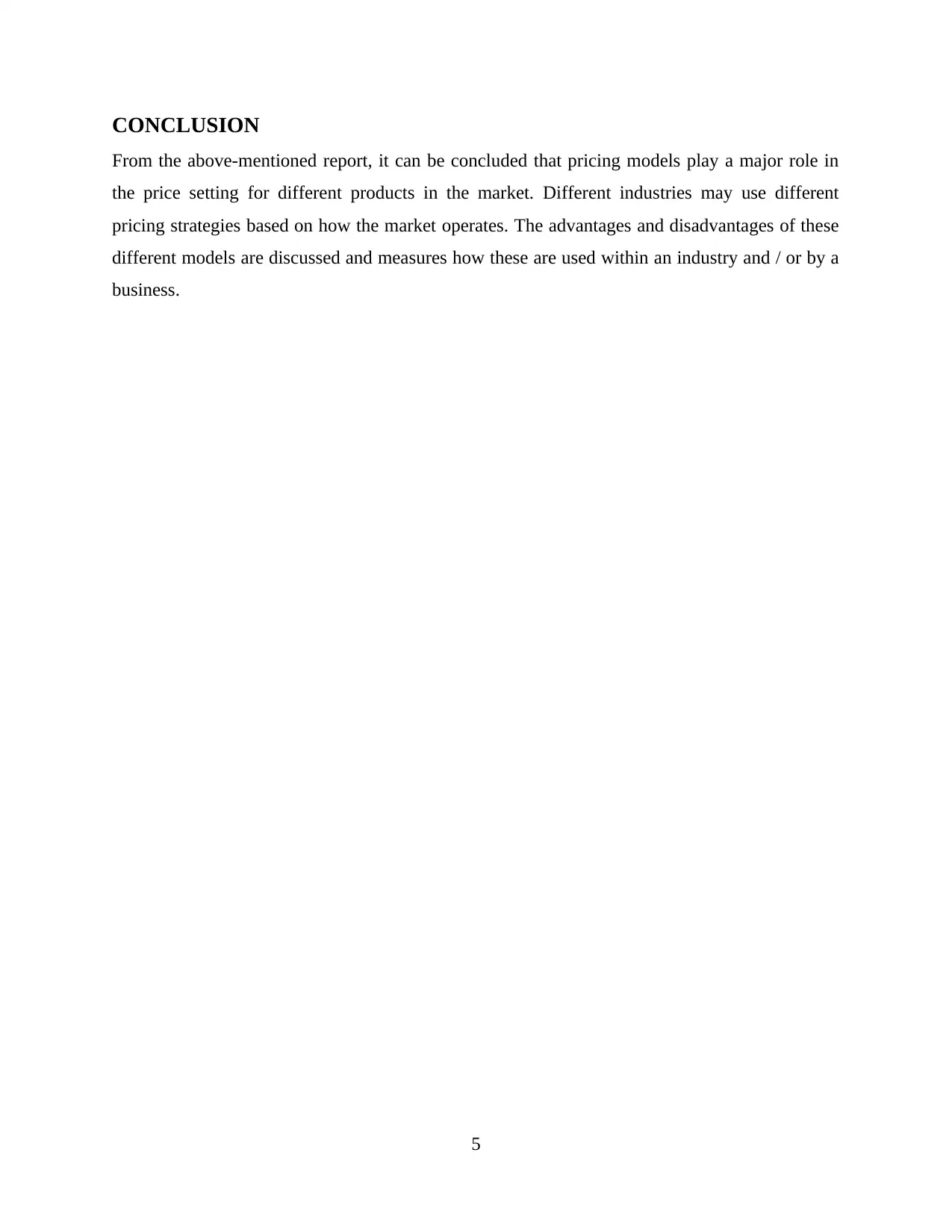
CONCLUSION
From the above-mentioned report, it can be concluded that pricing models play a major role in
the price setting for different products in the market. Different industries may use different
pricing strategies based on how the market operates. The advantages and disadvantages of these
different models are discussed and measures how these are used within an industry and / or by a
business.
5
From the above-mentioned report, it can be concluded that pricing models play a major role in
the price setting for different products in the market. Different industries may use different
pricing strategies based on how the market operates. The advantages and disadvantages of these
different models are discussed and measures how these are used within an industry and / or by a
business.
5
Paraphrase This Document
Need a fresh take? Get an instant paraphrase of this document with our AI Paraphraser
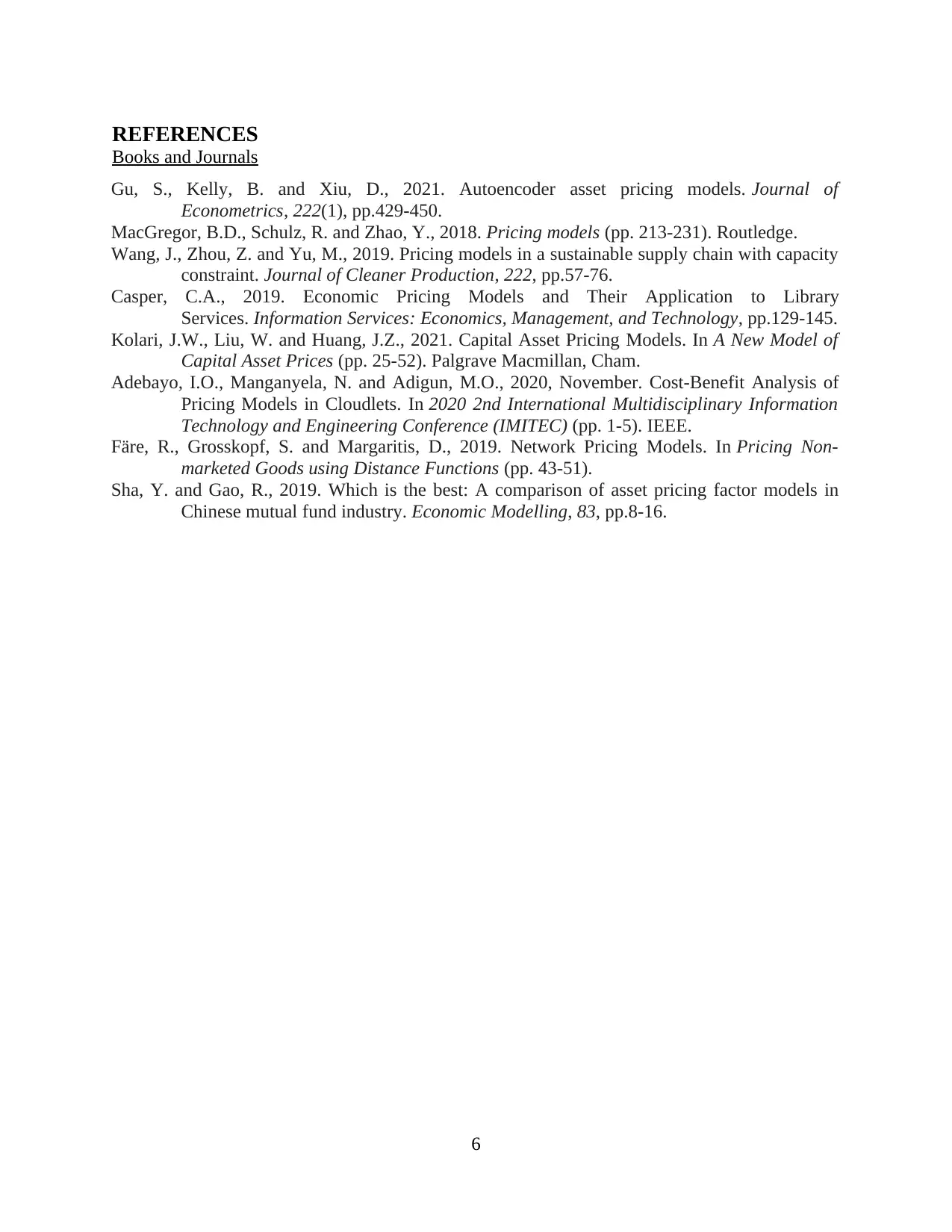
REFERENCES
Books and Journals
Gu, S., Kelly, B. and Xiu, D., 2021. Autoencoder asset pricing models. Journal of
Econometrics, 222(1), pp.429-450.
MacGregor, B.D., Schulz, R. and Zhao, Y., 2018. Pricing models (pp. 213-231). Routledge.
Wang, J., Zhou, Z. and Yu, M., 2019. Pricing models in a sustainable supply chain with capacity
constraint. Journal of Cleaner Production, 222, pp.57-76.
Casper, C.A., 2019. Economic Pricing Models and Their Application to Library
Services. Information Services: Economics, Management, and Technology, pp.129-145.
Kolari, J.W., Liu, W. and Huang, J.Z., 2021. Capital Asset Pricing Models. In A New Model of
Capital Asset Prices (pp. 25-52). Palgrave Macmillan, Cham.
Adebayo, I.O., Manganyela, N. and Adigun, M.O., 2020, November. Cost-Benefit Analysis of
Pricing Models in Cloudlets. In 2020 2nd International Multidisciplinary Information
Technology and Engineering Conference (IMITEC) (pp. 1-5). IEEE.
Färe, R., Grosskopf, S. and Margaritis, D., 2019. Network Pricing Models. In Pricing Non-
marketed Goods using Distance Functions (pp. 43-51).
Sha, Y. and Gao, R., 2019. Which is the best: A comparison of asset pricing factor models in
Chinese mutual fund industry. Economic Modelling, 83, pp.8-16.
6
Books and Journals
Gu, S., Kelly, B. and Xiu, D., 2021. Autoencoder asset pricing models. Journal of
Econometrics, 222(1), pp.429-450.
MacGregor, B.D., Schulz, R. and Zhao, Y., 2018. Pricing models (pp. 213-231). Routledge.
Wang, J., Zhou, Z. and Yu, M., 2019. Pricing models in a sustainable supply chain with capacity
constraint. Journal of Cleaner Production, 222, pp.57-76.
Casper, C.A., 2019. Economic Pricing Models and Their Application to Library
Services. Information Services: Economics, Management, and Technology, pp.129-145.
Kolari, J.W., Liu, W. and Huang, J.Z., 2021. Capital Asset Pricing Models. In A New Model of
Capital Asset Prices (pp. 25-52). Palgrave Macmillan, Cham.
Adebayo, I.O., Manganyela, N. and Adigun, M.O., 2020, November. Cost-Benefit Analysis of
Pricing Models in Cloudlets. In 2020 2nd International Multidisciplinary Information
Technology and Engineering Conference (IMITEC) (pp. 1-5). IEEE.
Färe, R., Grosskopf, S. and Margaritis, D., 2019. Network Pricing Models. In Pricing Non-
marketed Goods using Distance Functions (pp. 43-51).
Sha, Y. and Gao, R., 2019. Which is the best: A comparison of asset pricing factor models in
Chinese mutual fund industry. Economic Modelling, 83, pp.8-16.
6
1 out of 8
Related Documents
Your All-in-One AI-Powered Toolkit for Academic Success.
+13062052269
info@desklib.com
Available 24*7 on WhatsApp / Email
![[object Object]](/_next/static/media/star-bottom.7253800d.svg)
Unlock your academic potential
© 2024 | Zucol Services PVT LTD | All rights reserved.




